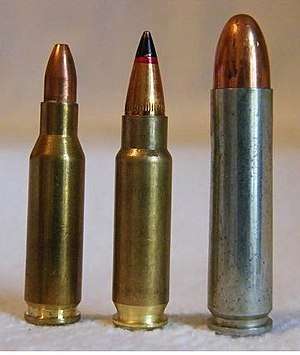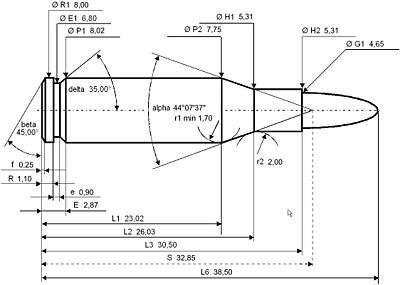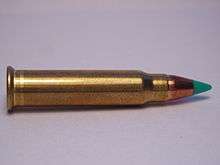HK 4.6×30mm
The HK 4.6×30mm (designated as the 4,6 × 30 by the C.I.P.[7]) cartridge is a type of ammunition primarily used in the Heckler & Koch MP7 Personal defense weapon (PDW). It is designed to minimize weight and recoil while increasing penetration of body armor. It features a bottlenecked case and a pointed, steel-core, brass-jacketed bullet.
| 4.6×30mm | ||||||||||||||||||||||||
|---|---|---|---|---|---|---|---|---|---|---|---|---|---|---|---|---|---|---|---|---|---|---|---|---|
 From left to right: 4.6×30mm (hollow point), 5.7×28mm, .30 Carbine. | ||||||||||||||||||||||||
| Type | Personal defense weapon | |||||||||||||||||||||||
| Place of origin | Germany | |||||||||||||||||||||||
| Service history | ||||||||||||||||||||||||
| In service | 2001–present | |||||||||||||||||||||||
| Used by | See Heckler & Koch MP7 Users | |||||||||||||||||||||||
| Wars | Afghanistan War[1] | |||||||||||||||||||||||
| Production history | ||||||||||||||||||||||||
| Manufacturer | Heckler & Koch | |||||||||||||||||||||||
| Variants | See Variations | |||||||||||||||||||||||
| Specifications | ||||||||||||||||||||||||
| Case type | Rimless, bottleneck | |||||||||||||||||||||||
| Bullet diameter | 4.65 mm (0.183 in) | |||||||||||||||||||||||
| Neck diameter | 5.31 mm (0.209 in) | |||||||||||||||||||||||
| Shoulder diameter | 7.75 mm (0.305 in) | |||||||||||||||||||||||
| Base diameter | 8.02 mm (0.316 in) | |||||||||||||||||||||||
| Rim diameter | 8.00 mm (0.315 in) | |||||||||||||||||||||||
| Rim thickness | 1.10 mm (0.043 in) | |||||||||||||||||||||||
| Case length | 30.50 mm (1.201 in) | |||||||||||||||||||||||
| Overall length | 38.50 mm (1.516 in) | |||||||||||||||||||||||
| Rifling twist | 160 mm (1 in 6.3 in) | |||||||||||||||||||||||
| Primer type | Boxer small rifle[2] | |||||||||||||||||||||||
| Maximum pressure | 400.00 MPa (58,015 psi) | |||||||||||||||||||||||
| Ballistic performance | ||||||||||||||||||||||||
| ||||||||||||||||||||||||
| Test barrel length: 180 mm Source(s): HK USA[3] HK USA[4] Modern Firearms, Pistol / SMG ammunation[5] Heckler & Koch Products[6] | ||||||||||||||||||||||||
Development
The 4.6×30mm cartridge was introduced in 1999.[8] It was designed as a competitor to FN Herstal's 5.7×28mm cartridge.[8]
Overview
Compared to standard intermediate cartridges one can carry more 4.6×30mm ammunition due to the lighter weight and relative small dimensions of the cartridge. Also, due to the lighter weight of the bullet, aiming in rapid fire is much easier as recoil depends much on the weight of the bullet. CRISAT testing shows that because of the smaller diameter and high projectile velocity of the round, body armor penetration is higher than that of traditional handgun projectiles.
A series of tests performed by NATO in the United Kingdom and France indicated that 5.7×28mm was a superior cartridge.[8] The results of the NATO tests were analyzed by a group of experts from France, the United States, Canada, and the United Kingdom and the group's conclusion was that the 5.7×28mm was "undoubtedly" the more efficient cartridge.[8]
Among other points, the NATO group cited superior effectiveness (27% greater) for the 5.7×28mm against unprotected targets and equal effectiveness against protected targets.[8] It also cited less sensitivity to extreme temperatures for the 5.7×28mm and cited a greater potential risk of barrel erosion with the 4.6×30mm.[8] In addition, the group pointed out that 5.7×28mm is close to the 5.56×45mm NATO by its design and manufacture process, allowing it to be manufactured on existing production lines.[8] The group also pointed out that 5.7×28mm weapons are more mature than 4.6×30mm weapons, and the 5.7×28mm FN Five-seven pistol was already in production at that time, while the 4.6×30mm Heckler & Koch UCP pistol was still only an early concept.[8] However, the German delegation and others rejected the NATO recommendation that 5.7×28mm be standardized, and as a result, the standardization process was indefinitely halted.[1][8]
Cartridge dimensions
The 4.6×30mm has 0.87 ml (13.4 grains) H2O cartridge case capacity.

4.6×30mm maximum C.I.P. cartridge dimensions; all sizes in millimeters (mm).[7]
Americans define the shoulder angle at alpha/2 ≈ 22 degrees. The common rifling twist rate for this cartridge is 160 mm (1 in 6.3 in), 6 grooves, Ø lands = 4.52 mm, Ø grooves = 4.65 mm, land width = 1.21 mm and the primer type is small rifle.[2]
In C.I.P. (Commission Internationale Permanente pour l'Epreuve des Armes à Feu Portatives) regulated countries every rimless rifle cartridge combo has to be proofed at 125% of this maximum C.I.P. pressure to certify for sale to consumers. This means that 4.6×30mm chambered arms in C.I.P.-regulated countries are currently (2018) proof tested at 500.00 MPa (72,519 psi) PE piezo pressure.[7]
The Belgian 5.7×28mm cartridge introduced in 1993 is probably the closest currently available ballistic twin of the 4.6×30mm.
The 4.6×30mm ammunition is produced by RUAG Ammotec, Fiocchi and BAE Systems, it seems RUAG has the widest product range.
Variations
2 g DM11 Penetrator Ultimate Combat
The German Army version of the 4.6×30mm cartridge (DM11 Penetrator) weighs 6.5 g and uses a 2 g copper-plated steel bullet projectile at 720 m/s (2,362 ft/s) muzzle velocity. The DM11 Penetrator cartridge is designed for the MP7. The Ultimate Combat can penetrate the NATO CRISAT target at more than 300 meters. This ammunition combines energy transfer in soft targets and very good penetration.[9] The muzzle velocity V0 and V100 indicate a G1 ballistic coefficient of approximately 0.141 to 0.150 (BCs are somewhat debatable) making the DM11 projectile aerodynamically more efficient compared to typical service handgun projectiles, but less efficient compared to typical assault rifle projectiles. At the stated effective range of 200 m the DM11 projectile will be traveling at approximately Mach 1.25 (425 m/s) under ICAO Standard Atmosphere conditions at sea level (air density ρ = 1.225 kg/m3).
2 g Action Law Enforcement hollow point
The Action 4.6×30mm Law Enforcement cartridge weighs 6.5 g and is loaded with a 2 g CuZn-alloy (brass) solid hollow point projectile that achieves 700 m/s (2,300 ft/s) muzzle velocity. The cartridge is designed for the MP7. This ammunition is optimized for energy transfer in soft targets and should offer decent penetration performance on hard and combined targets like car doors or glass and body armor.[10] The muzzle velocity V0 and V50 indicate a G1 ballistic coefficient of approximately 0.112 to 0.119. At the stated effective range of 200 m the 2 g Action projectile will be traveling at approximately Mach 1.67 (586 m/s or 1923 f/s) under ICAO Standard Atmosphere conditions at sea level (air density ρ = 1.225 kg/m3).
Action Law Enforcement cartridge technical data:[11]
- Temperature range: -30 °C to + 52 °C
- Velocity/energy at 0 m: 700 m/s /480 Joules
- Velocity/energy at 50 m: 568 m/s / 322 Joules
- Ballistic coefficient C 1: 0.112 - 0.119 (ICAO)/(Army Metro)
- Mean chamber pressure: max. 400 MPa
- Penetration in 20% gelatine: bare at 25 m: < 30 cm
- Accuracy at 50 m: Ø 5 cm
- Effective service range: 200 m (656 ft)
2.7 g full metal jacket 4.6×30mm
The ball 4.6×30mm cartridge weighs 7 g and is loaded with a 2.7 g full metal jacket projectile with a PbSb – alloy core and a steel copper-plated jacket that achieves 600 m/s (2,000 ft/s) muzzle velocity. The cartridge is designed for the MP7. This ammunition is optimized for energy transfer in soft targets and offers good precision.[12] The muzzle velocity V0 and V100 indicate a G1 ballistic coefficient of approximately 0.171 to 0.187. At the stated effective range of 200 m the 2.7 g Ball projectile will be travelling at approximately Mach 1.36 (463 m/s) under ICAO Standard Atmosphere conditions at sea level (air density ρ = 1.225 kg/m3).
Ball cartridge technical data:[13]
- Temperature range: between -54 °C and +52 °C
- Velocity/energy at 0 m: 600 m/s / 486 Joules
- Velocity/energy at 100 m: 463 m/s / 320 Joules
- Ballistic coefficient C 1: 0.171 - 0.187 (ICAO)/(Army Metro)
- Mean chamber pressure: max. 400 MPa
- Penetration in gelatine bare at 25 m: < 35 cm
- Accuracy at 100 m: Ø 8 cm
- Effective range:~300 m (984 ft) (HK claims that the FMJ round has more retained energy than the "Combat Steel" due to the FMJ's heavier projectile.)
Others
VBR produces a 4.6×30mm two-part controlled fragmenting projectile that is claimed to increase the content of the permanent wound cavity and double the chance to hit a vital organ.[14] Heckler & Koch claims that the CPS Black Tip ammunition made by Fiocchi has a muzzle energy of approximately 525 J that would be comparable to 9×19mm rounds.[15][16]
See also
- 4 mm caliber
- 4.38×30mm Libra
- 4.5×26mm MKR
- 5.7×28mm
- 5.8×21mm DAP92
- 7.92×24mm
- List of cartridges by caliber
- List of rifle cartridges
- Table of handgun and rifle cartridges
Weapons
- Heckler & Koch MP7
- Heckler & Koch UCP
- ST Kinetics CPW
- TVGK
- VBR-CQBW
References
- Gourley, S.; Kemp, I (November 26, 2003). "The Duellists". Jane's Defence Weekly (ISSN 0265-3818), Volume 40 Issue 21, pp 26–28.
- "Suppressed Rifle Cartridges". Raygun.10gauge.de. 2007-04-23. Retrieved 2012-02-13.
- "Fiocchi - SFN Ram". Heckler-koch.com. Retrieved 2012-02-13.
- "Heckler & Koch :: Products". Hkd-usa.com. Archived from the original on 2011-10-01. Retrieved 2012-02-13.
- "Modern Firearms - Pistol / SMG ammunition". World.guns.ru. Archived from the original on 2012-02-13. Retrieved 2012-02-13.
- "01 December 2011, brochure (Energy and velocity at 10 m)". Retrieved 2012-02-13.
- C.I.P. TDCC 4,6 × 30
- Oliver, David (2007). "Global Defence Review — In the Line of Fire". GDR Publications. Archived from the original on October 16, 2006. Retrieved 2009-10-19.
- RUAG Ammotec 2.0 g German Army 4.6×30mm Penetrator DM11 cartridge factsheet
- RUAG Ammotec 2.0 g Law Enforcement 4.6×30mm cartridge factsheet
- RUAG Ammotec 2.0 g Law Enforcement 4.6×30mm cartridge factsheet
- RUAG Ammotec 2.7 g Full Metal Jacket 4.6×30mm cartridge factsheet
- RUAG Ammotec 2.7 g Full Matal Jacket 4.6×30mm cartridge factsheet
- "The 4.6x30 mm B2F cartridge". Fsdip.com. Archived from the original on 2012-03-11. Retrieved 2012-02-13.
- "Heckler & Koch :: Products". Heckler-koch.de. Retrieved 2012-02-13.
- "Modern Firearms - Pistol / SMG ammunition". World.guns.ru. Archived from the original on 2010-09-02. Retrieved 2012-02-13.
External links
- UCP overview on world.guns.ru
- MP7 PDW overview on world.guns.ru
- PDW and 4.6 ammo overview on hkpro.com
- JBM Small Arms Ballistics Ballistic Coefficient (Velocity) Calculator
| Wikimedia Commons has media related to 4.6x30mm. |
